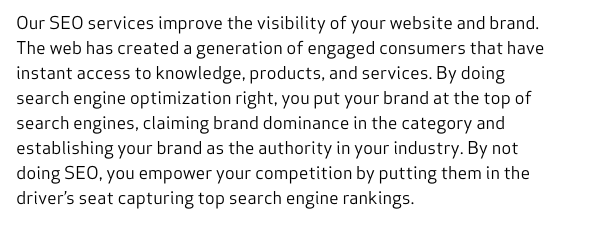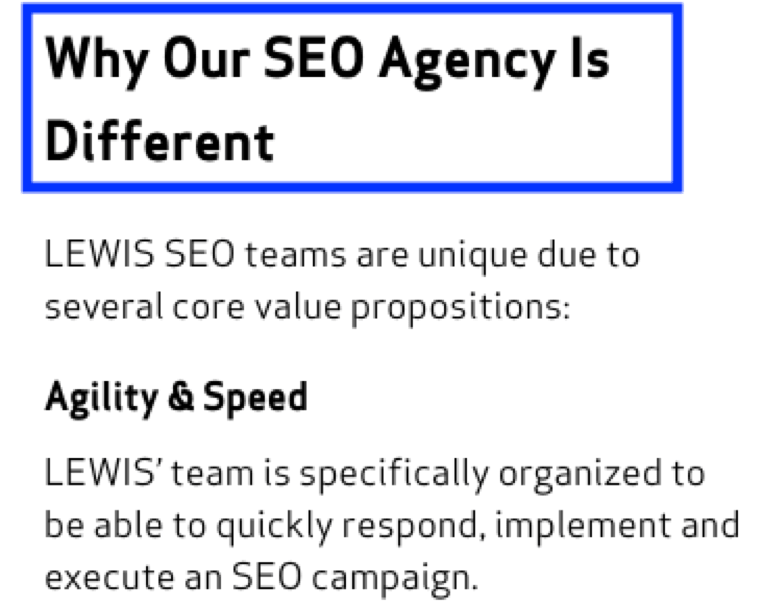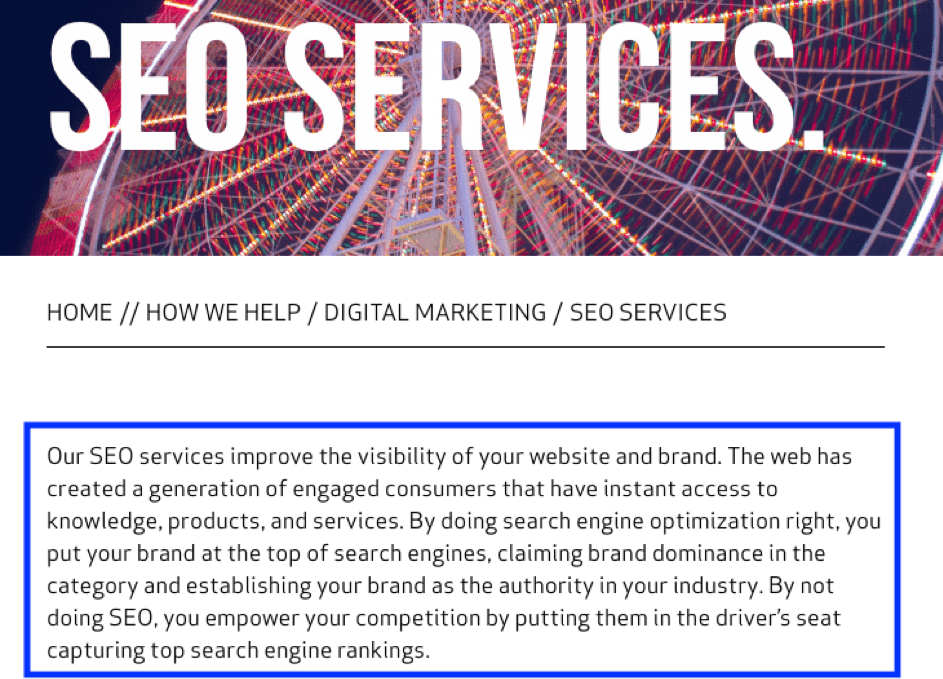Meta Title Tag
What: A back end element that appears in two places. The first, located in the SERPs, above the meta description as the clickable headline for a given ranked URL. The second, on the browser tab at the top of the designated web. Each example can be seen below in figures 1 and 2. Pages are important because they help indicate to search engines the overarching topic and content of the page to assign rankings.


Attributes
- 512 pixels, or roughly 55 characters (test meta title tags longer than 55 chars with a simulator).
- Include one or two of the most relevant high volume non-branded keywords.
- Use the keyword planner tool to perform keyword research.
- Put important keywords closest to the front of the meta title tag as possible.
- Example: SEO Services & Affordable SEO Consulting
- The first letter of each word should be capitalised.
- Conjunctions and prepositions should remain all lowercase.
- Example: SEO Services and Affordable SEO Consulting
- The brand name should go at the end of the meta title tag as this will help the URL rank for a branded search query.
- Example: | LEWIS
- The Oxford comma is omitted and use the ampersands in lieu of “and” to save character space.
- This does not go against any search engine protocol or negatively impact CTR,
- Example: SEO Services & Affordable SEO Consulting | LEWIS
Meta Description
What: A back end element that is not visible on the front end of a site, only visible underneath the meta title tag of a ranking URL in SERPs when results are returned to searchers. Meta descriptions are no longer a search engine optimisation ranking factor but are vital for click-through rate (CTR), which is one of several factors that correlate highly with positive rankings. A well-written meta description gives users a glimpse at your pages’ contents and can entice searchers to click through to your site. A meta description tag is denoted in HMTL as <meta name = “description” content= “Our SEO services put your brand at the top of the search engines, claiming brand dominance in the category and establishing your business as the authority.”/>

- The recommended meta description length is 920 pixels or roughly 155 characters or less including spaces (test meta description length longer than 155 characters with a simulator).
- Include the targeted keyword phrase of the meta title tag in the description, no more than twice.
- Use the keyword planner tool to perform keyword research.
- Put important keywords closest to the front of the meta description tag.
- It is not always necessary to include the brand name in the meta description because it is already present in the meta title tag and page URL.
- Avoid using unnecessary symbols or punctuation when possible. Additional hyphens, quotations, parenthesis, etc. can take up character space.
- Include secondary keywords relevant to the targeted ones if possible.
- Secondary Keywords: search engines, authority, business
- Ampersands are used in lieu of “and” to save character space.
- This does not go against any search engine protocol or negatively impact click-through-rate
- Include unique selling points or call to action when applicable (character space permitting).
- Example: complimentary SEO audit, 25% off the first-month retainer, etc.
- Every meta description should be unique and different.
Header 1 (h1):
What: An on-page element that is visible to readers and displays the overall theme of the page. The h1 is similar to the page meta title tag, in that it gives meaning and summarises a page’s content. The h1 should be located at the top of the page and appear in the largest font size. The meta title tag of the page should be wrapped in the <h1>. For example: <h1>SEO Services</h1>



Attributes:
- It is recommended that there is one h1 per page.
- Include the same or similarly relevant high-volume search terms as the meta title tag.
- Use the keyword planner tool to perform keyword research.
- Targeted keywords: SEO Services
- H1 Example: SEO Services
Header 2 (h2)
What: An on-page element that is visible to readers that acts as a subheader to the h1. An h2 is often utilised best when more text exists on the page, splitting up smaller content subsections. The <h2> tag should contain similar high-volume search terms that are relevant to the theme of the page and its respective content. For example: <h2>Why our SEO Agency is Different<h2>

- Multiple H2’s can be utilised when appropriately placed within the context of a page.
- The important thing is to create a clear and easy to follow header hierarchy.
- Include relevant searched terms from the meta title tag.
- Use the keyword planner tool to perform keyword research.
- H2 Example: SEO Agency, SEO Professional Services
- If there is only one targeted keyword phrase for the page and has been used in h1 it is best to include a secondary semantically related keyword for the h2.
Body Copy:
Body Copy: The visible, informative content on the page that users want to see and read. This body section can include text, images, video, tables, graphs, audio, and much more.

Attributes:
- According to Google, content should contain rich information that clearly indicates the theme of the page and provides insight to readers.
- Include targeted and secondary keywords throughout the page copy (often words that were used in the metadata).
- Keywords should appear 2-3 times throughout the body content.
- Avoid keyword stuffing as it will compromise the quality of the page.
- Create content that helps to answer users’ search queries, engages users and encourages them to share.
- Be unique and provide value to the reader.
Meta Keywords Tag
What: As of 2009 Google announced that its search engine no longer used the meta keyword tag field as a web ranking search factor. Previously, Google’s algorithm included the meta keyword field as a ranking factor. As time went on people began stuffing keywords into the meta keyword field that had nothing to do with the content of the page. Searchers were being served irrelevant pages to their queries, which provided a poor user experience on Google’s Search Engine.
Check out more information about our SEO services or browse one of our other educational on-site SEO blog post like site depth.



